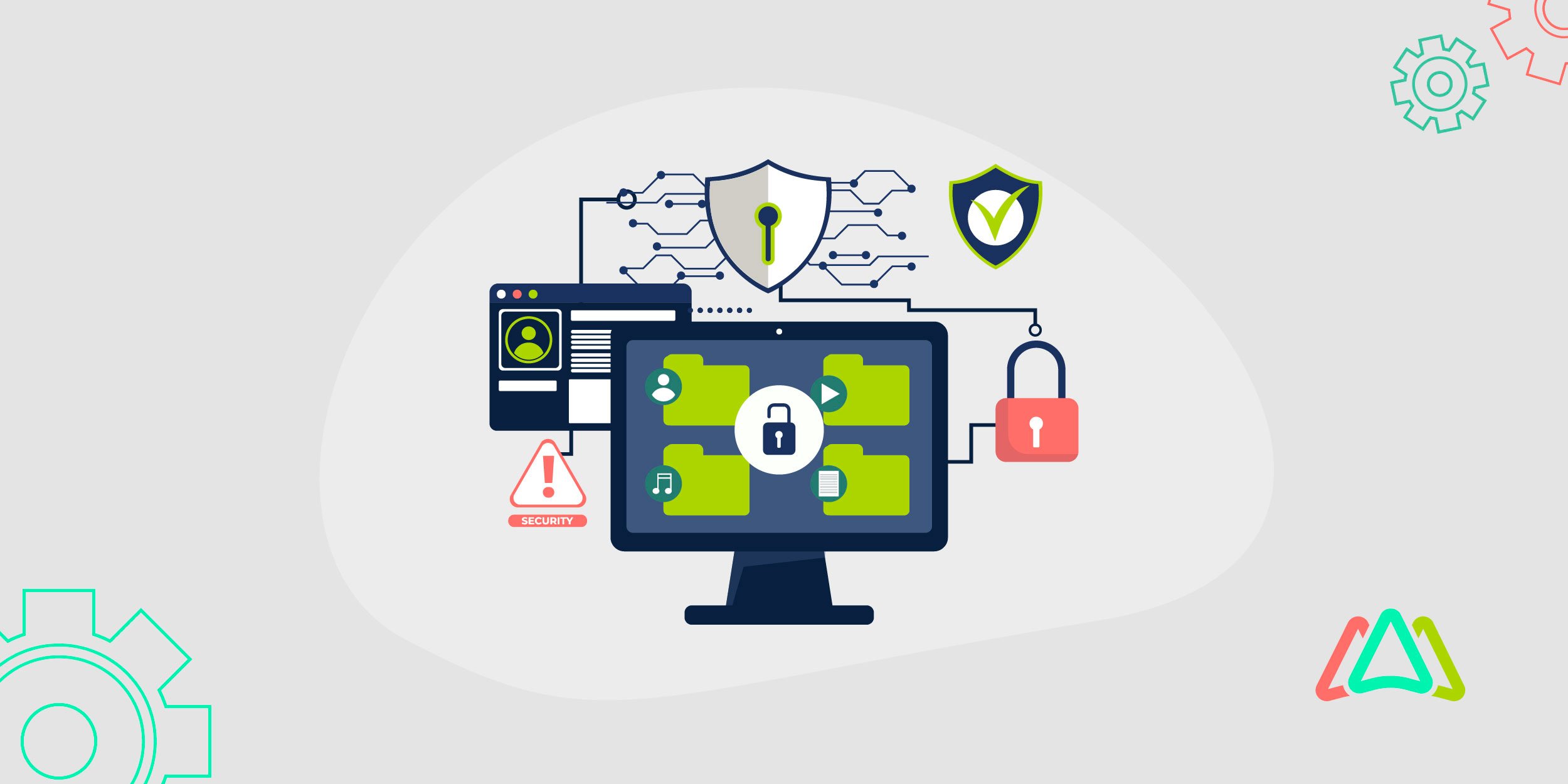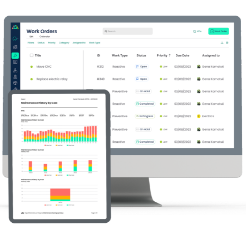
Cybersecurity in CMMS Environments
As Computerized Maintenance Management Systems (CMMS) become more connected and cloud-based, they also become more vulnerable, making them a potential entry point for cybercriminals who want to harm the operations of organizations. A successful breach could interfere with maintenance procedures and cause equipment failures, postponed repairs, and eventually production halts.
Yet, many organizations still overlook CMMS platforms when designing their cybersecurity strategies. This gap exposes critical operational data, weakens infrastructure resilience, and puts uptime, safety, and compliance at risk. This article explores why CMMS systems are attractive targets, where vulnerabilities exist, and how to build a defense strategy that keeps maintenance operations secure.
Why Hackers Target CMMS Systems
The numbers don't lie: Industrial cybersecurity incidents have jumped 110% in recent years. As our systems become more connected, the problem only worsens.
CMMS software isn’t just a work order tool; it’s a rich target for attackers, a goldmine of sensitive information at the crossroads of your IT and operational technology networks. It holds sensitive operational data, bridges IT and OT networks, and can expose critical infrastructure. A breach can stop production, making CMMS systems prime ransomware targets. As industrial cyberattacks rise, having measures in place that reduce risk is key.
Cybercriminals target CMMS platforms for five reasons that make these systems particularly valuable for malicious activities:
Critical Infrastructure Disruption
When hackers hit your CMMS with ransomware, they don't just lock up files; they can instantly stop your entire operation. Maintenance teams can't access work orders, equipment manuals, or safety procedures. Remember the Colonial Pipeline cyber attack in 2021? In May of 2021, the Colonial Pipeline (one of the largest fuel pipelines in the United States) was hit with a ransomware attack by the hacker group DarkSide. The attack led to the company shutting down its pipeline operations, causing widespread fuel shortages and chaotic buying. The company ended up paying a ransom of nearly $4.4 million to restore operations. This is an example of the chaos that can occur as a result of a hack that makes these systems such attractive targets.
Valuable Data Harvesting
Your equipment specifications and maintenance schedules are detailed blueprints of your facility. This information helps hackers plan physical attacks, gather competitive intelligence, or set up future cyberattacks with pinpoint accuracy.
Perfect Stepping Stone
A CMMS can have privileged access to SCADA systems, manufacturing equipment, and safety systems. Hackers use compromised CMMS credentials to escalate their privileges and penetrate your critical infrastructure.
Regulatory Pressure Points
For businesses in healthcare, utilities, or transportation, hackers know you face severe penalties for operational disruptions. That regulatory pressure makes you more likely to pay ransoms quickly.
Supply Chain Infiltration
Here's a clever trick hackers use: instead of attacking hundreds of companies individually, they target CMMS vendors or managed service providers. One successful breach gives them access to dozens or hundreds of customer environments. In April 2023, Brightly Software’s SchoolDude platform suffered a breach that exposed over three million users' maintenance schedules, asset data, and personal details. The attack exploited vulnerabilities in data management, highlighting the growing risks in digital maintenance systems.
How CMMS Hack Impacts Production
Understanding why hackers target maintenance systems is useful, but what really matters is the damage they cause on the ground. When your CMMS is compromised, the ripple effects can hit production hard. Here’s what that can look like:
Maintenance Disruptions
When a system is breached, scheduled maintenance tasks can disappear, get changed, or become completely inaccessible. As a result, essential machines might miss their routine servicing, making sudden breakdowns more likely. This doesn’t just slow things down; it can throw your entire production schedule off track.
Downtime Escalation
A cyberattack can freeze the CMMS platform entirely, preventing access to work orders, repair logs, and inventory levels. Without this visibility, teams operate blind, and delays compound quickly, especially in facilities that rely heavily on just-in-time maintenance.
Asset Data Manipulation
If attackers alter asset histories or maintenance logs, teams may make misinformed decisions based on false data. This can lead to premature equipment failures, safety risks, or replacing parts that don’t require service.
Inventory and Procurement Delays
A compromised CMMS can affect parts reordering, stock level tracking, and vendor communication. The result is longer repair lead times, inflated maintenance costs, and production hold-ups due to missing components.
Safety and Compliance Violations
Tampering with safety inspection records or regulatory maintenance logs can put the company at legal and operational risk. This could mean fines, shutdowns, or damaged reputations in highly regulated industries.
How Hackers Break Into Your CMMS
Understanding how cybercriminals infiltrate CMMS environments requires examining four critical attack vectors that form the complete threat landscape. Think of these as the doors and windows they use to break into your digital house:
Your Application Layer
This is where your web-based CMMS and mobile apps, your technicians use in the field, live. Hackers exploit weak spots like SQL injection flaws, authentication problems, and poor session management. Your mobile apps are especially vulnerable because they often lack the same security controls as your central enterprise systems.
Your Data Layer
This is where all your valuable maintenance data lives: work orders, asset specs, equipment details. Hackers can steal or manipulate this information if your databases aren't encrypted or your access controls are weak.
Your Network Infrastructure
Here's where things get tricky. Your CMMS connects to industrial control systems, IoT sensors, and corporate networks simultaneously, each a potential pathway for hackers. Remote access, which you need for field technicians, makes this even more complicated.
Your Integration Points
Every third-party connection, API, and vendor relationship creates another potential entry point. When you connect your CMMS to your ERP system or those new IoT sensors, you create pathways hackers can use to jump between systems.
Common CMMS Security Weaknesses
The most frequent vulnerabilities in CMMS environments fall into distinct categories, each requiring specific mitigation approaches:
Weak Authentication
You'd be surprised how many organizations still use default passwords or shared accounts for maintenance technicians. Manufacturing plants are known for this. Utilities often forget to disable vendor access credentials, and healthcare facilities struggle with BYOD (bring your own device) policies.
Data Protection Deficiencies
Unencrypted databases are everywhere. Energy companies store critical infrastructure details in unprotected systems, while transportation companies send maintenance communications in plain text between field technicians and headquarters.
Network Security Gaps
Food processing facilities use unsecured WiFi for maintenance devices and data centers, with no separation between maintenance networks and critical systems. The list goes on.
Integration Security Flaws
Hotels have unsecured connections between CMMS and building automation systems. Schools fail to secure IoT sensor connections properly, and these trusted relationships become highways for hackers.
Building a Bulletproof CMMS Security Framework
Conduct a Comprehensive Security Assessment
Conduct vulnerability scanning, penetration testing, and compliance audits to establish your current security condition. Then, document all CMMS integrations, data flows, and access points to create a complete security baseline.
Implement Strong Authentication Controls
Deploy multi-factor authentication for all users, establish role-based access controls, and enforce strong password policies. Create individual user accounts with unique credentials and implement session timeouts to prevent unauthorized access.
Establish Data Protection Protocols
Encrypt all CMMS databases and communications using industry-standard protocols like HTTPS. Implement secure backup procedures with off-site storage and develop data classification policies that identify and protect sensitive maintenance information.
Deploy Network Security Measures
Install firewalls and intrusion detection systems to monitor network traffic. Implement network segmentation to isolate CMMS systems from other critical infrastructure, and regularly scan for vulnerabilities using security tools.
Secure CMMS Integrations
Evaluate all third-party connections and implement secure API protocols. Establish vendor security requirements and review integration security controls regularly to ensure ongoing protection.
Develop Incident Response Procedures
Create comprehensive breach response plans, implement security monitoring systems, and establish recovery protocols. Regular security drills ensure teams can respond effectively when incidents occur.
Overcoming Implementation Challenges
Organizations face predictable obstacles when implementing CMMS security, but proven solutions exist for each common challenge:
Legacy System Limitations
Older CMMS platforms with limited security features require phased modernization approaches. Begin by implementing network-level controls and access management while planning system upgrades that provide enhanced security capabilities.
Evaluate Your CMMS Provider’s Security Policies
One of the best preventive measures an organization can take is to evaluate the security policies and practices of the CMMS provider. When it comes to SaaS (Software as a Service), there are certifications that the CMMS provider can attain that demonstrate that the software company is in good standing when it comes to security.
Examples include ISO27001 and SOC2. If the provider has these certifications, it means that they have undergone an in-depth, independent 3rd party audit and check the boxes with respect to implementing practices that ensure security and compliance. Examples of such practices are employees using MFA for software applications, and before hiring staff, going through criminal background checks.
Budget Constraints
Cost-effective security solutions focus on high-impact, low-cost measures first. Implementing strong authentication controls and basic encryption provides significant security improvements without major capital investments.
Operational Continuity
Balance security measures with maintenance operations by implementing changes during planned maintenance windows and providing adequate training to minimize productivity impacts during security upgrades.
While you implement these security measures, it's worth considering what's next in CMMS cybersecurity.
The Future of CMMS Cybersecurity
Emerging technologies will reshape CMMS security over the next decade. AI-powered threat detection systems will identify anomalous behavior in maintenance operations, while zero-trust architecture principles will verify every access request regardless of user location or device. Blockchain technology will provide tamper-proof maintenance records, and advanced behavioral analytics will detect insider threats before they cause damage.
Industry 4.0 convergence will require new security approaches as CMMS platforms integrate more deeply with IoT sensors, digital twins, and autonomous maintenance systems. Organizations that invest in advanced security capabilities today will be better positioned to leverage these emerging technologies safely.
Securing CMMS Environments
Cybersecurity can no longer be an afterthought in maintenance operations. Start by assessing your CMMS environment for vulnerabilities and high-risk integrations. Prioritize essential safeguards like multi-factor authentication and encryption, then build a phased plan to secure your network, vendors, and response protocols. Your CMMS is more than a tool—it’s central to keeping assets running, staying compliant, and avoiding costly disruptions. First, focus on the highest-risk areas, document quick wins, and scale what works. Cyber threats are growing fast. Don’t wait to secure what matters most.
TABLE OF CONTENTS
Keep Reading
Spare parts management within maintenance can make the difference between a problem-free ...
16 Dec 2025
Every maintenance team eventually faces the same question: When should we repair, and when ...
12 Dec 2025
Enterprise Asset Management (EAM) software has become a cornerstone for organizations aiming ...
12 Dec 2025
Unexpected equipment breakdowns can disrupt operations, increase repair costs, and reduce ...
11 Dec 2025
Businesses are always looking for ways to improve efficiencies, reduce costs, and improve ...
9 Dec 2025
The longest U.S. federal government shutdown to date lasted 43 days, beginning on October 1, ...
5 Dec 2025
Every maintenance professional faces it sooner or later — that critical time when an aging ...
18 Nov 2025
The term 'best' is often used loosely, without a clear understanding of its context or ...
14 Nov 2025
In the not too distant past, maintenance strategies have been defined by reaction—fixing ...
13 Nov 2025
Tax season is the time of year that often sends a ripple of anxiety through many of us. The ...
11 Nov 2025
Selecting a Computerized Maintenance Management System (CMMS) can, at first glance, be an ...
4 Nov 2025
In healthcare facilities, equipment uptime involves more than achieving operational ...
31 Oct 2025
Companies are subject to economic ups and downs, also known as economic volatility. Today, ...
30 Oct 2025
Maintenance challenges are a constant struggle, with unplanned downtime costing manufacturers ...
27 Oct 2025
Last winter, a maintenance technician at a U.S. paper mill ignored a predictive alert that ...
10 Oct 2025
Many organizations proudly say they “have a CMMS,” but ownership alone doesn’t equal ...
9 Oct 2025
Every maintenance team is under pressure to do more with less. Unplanned downtime is often ...
7 Oct 2025
The implementation of simple, yet powerfully effective, checklists has repeatedly ...
3 Oct 2025
In manufacturing, every second counts. When production stops, whether due to scheduled ...
2 Oct 2025
The increasing cost of maintenance, lack of accountability, and siloed systems leave many ...
30 Sep 2025







